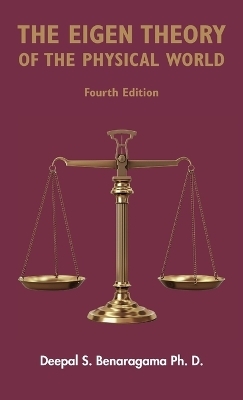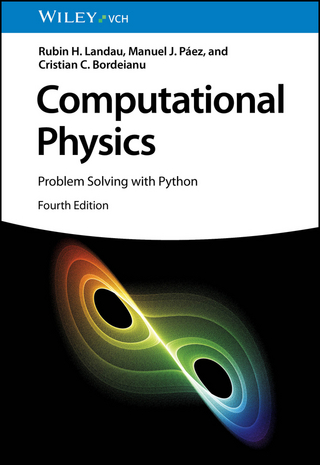
The Eigen Theory of the Physical World - Fourth Edition
Grosvenor House Publishing Ltd (Verlag)
978-1-80381-853-5 (ISBN)
- Titel nicht im Sortiment
- Artikel merken
This book, which is the fourth edition of the Eigen Theory of the Physical World, presents the eigen theory of the natural physical world of geometrical origin the principal feature of which happens to be the proper form of dark matter. According to this theory the fundamental form of a particle of matter is a continuous distribution of points that forms a manifold of its own. Each of these points results from the intersection of a corresponding pair of eigen velocity vectors that generate the wave aspect of the wave-particle duality of matter. The theory evolves in three stages. The first stage develops the pair of eigen velocity vectors. These vectors are complete with their own field of a pair of symmetric and antisymmetric tensors characteristic of gravitation and electromagnetism respectively. The second stage transforms the wave aspect into its very opposite, the particle aspect, as a pair of particles that are the progenitors of proton and electron. The base manifolds of these particles are made up of the proper form dark matter. The third stage brings together proton and electron as the Hydrogen atom which in effect is the proper particle aspect of the wave-particle duality of matter. In the eigen theory General Relativity becomes complete and Quantum Mechanics gets restructured; in particular the principle of uncertainty ceases to exist.
PREFACE
ACKNOWLEDGEMENTS
CHAPTER 1
Introduction1
1.1 Newtonian Mechanics and General Relativity 1
1.2 The Eigen Theory 2
1.3 The wave aspect of the wave-particle duality of matter 6
1.4 The particle aspect of the wave-particle duality of matter 11
1.5 A simple view of the structure of each of the pair of particles of matter that the wave aspect separates into13
CHAPTER 2 17
Balance 17
2.1 Symmetry misinterpreted as balance 17
2.2 Balance as the highest principle of nature 18
CHAPTER 3 25
A Brief History of Physics 25
3.1 The early stages of physics 25
3.2 Newtonian mechanics 33
3.3 Relativistic physics 38
3.4 Quantum mechanics 41
CHAPTER 4 43
The Eigen Theory of the Physical World 43
4.1 Introduction 43
4.2 The First stage of the Eigen Theory 46
4.2.1 The wave aspect of the wave-particle duality of matter 46
4.2.2 Absolute conservation principle 50
4.2.3 The mutual transport equations of v and u and the field eqn. that determines g and h 52
4.2.4 The three fundamental eqns. F1, F2 and F3 56
4.3 The second stage of the Eigen Theory 57
4.3.1 The particle aspect of the wave-particle duality of matter 57
4.4 The third stage of the Eigen Theory 60
4.4.1 The base manifold that envelops proton and electron particle centres 60
4.4.2 The proper space that envelops proton and electron 62 4.4.3 Proton and electron together as the hydrogen atom 62
CHAPTER 5 67 Simple Applications of ET 67
5.1 Principle of uncertainty 67
5.2 Matter-antimatter 67
5.3 Double-slit experiment 67
5.3.1 Particles of matter 67
5.3.2 Photons 68 vii CHAPTER 6 69 Application of ET to Cosmic Central Body Systems 69
6.1 Planetary and galactic systems 69
6.2 Field solutions of the cosmic central body systems 70
6.2.1 Field solution of the proper space 70
6.2.2 Field solution of the base manifold 70
6.2.3 Field solution of the central body 70
6.3 Motion of a satellite of mass, negligible in comparison to the central body mass 71
6.4 Use of equation (44) in 6.3 to obtain the contribution made by the base manifold to the rotational speeds of stars in the M33 galaxy 73
6.5 Gravitational lensing 74
Discussion and Conclusions. 75 References 91
Bibliography 93
| Erscheinungsdatum | 04.06.2024 |
|---|---|
| Reihe/Serie | The Eigen Theory of The Physical World ; 4 |
| Zusatzinfo | 3 black and white images |
| Verlagsort | Claygate |
| Sprache | englisch |
| Maße | 140 x 216 mm |
| Gewicht | 288 g |
| Themenwelt | Naturwissenschaften ► Physik / Astronomie |
| ISBN-10 | 1-80381-853-0 / 1803818530 |
| ISBN-13 | 978-1-80381-853-5 / 9781803818535 |
| Zustand | Neuware |
| Haben Sie eine Frage zum Produkt? |
aus dem Bereich


